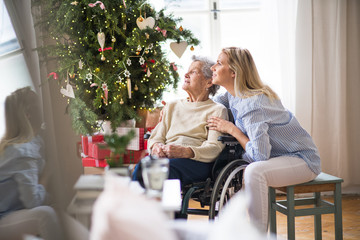Holiday Home Accessibility Checklist
Posted on by John Burfield
 The holiday season is normally the time of year when we gather with family and friends, especially those that we may not see too often.
The holiday season is normally the time of year when we gather with family and friends, especially those that we may not see too often.
When we reside in the same living space every day, we tend to get used to how things are, overlooking accidents waiting to happen. Sometimes a small change is all it takes to keep family members safe. If you find problem areas in your loved one's home, consider contacting an experienced home access provider for an accessibility assessment. Many providers will offer them free of charge and will be able to provide the right solution to fit your needs and budget.
Unsure where to start? Lifeway's checklist below is the perfect place to begin as it highlights potential problem areas and fall hazards in the home.
1. Exterior Entrances and Exits
- Note condition of driveway and walkways – Look for cracks, potholes, etc., and ensure they are even and free from obstacles
- Note amount of light for driveway, walkways, and porch
- Make sure bushes and shrubs do not block doorways, walkways or driveways
- Look for handrails on entryway steps and note their condition
- Check the height of door threshold – Make sure user can safely step over
- Note the ability to use doorknob, door locks, mailbox, etc.
2. Interior Doors, Stairs, and Hallways
- Note height of thresholds and width of interior doors – Determine which direction doors swing
- Note the width of hallways and determine if they are wide enough to use a walker, wheelchair, etc.
- Note if the user can navigate the stairway safely – Is the stairway straight or curved?
- Note if stairway has proper lighting
- Note condition of stairway railings – Determine if they are properly secured
3. Kitchen
- Note height of sink and counters – Determine if the user can safely reach them
- Note height of storage cabinets – Determine if they can be accessed safely
- Note if there is space for a wheelchair user to navigate the kitchen and use the sink, oven, etc.
4. Bathroom
- Determine if the user can operate sink, tub, and shower faucets
- Determine the ability to safely enter and exit shower or bathtub
- Determine if there is enough room for tub/shower bench if needed
- Determine the height of the toilet and user’s ability to access safely – Note the ability to sit, stand, reach toilet paper, flush, etc.
- Determine if there is enough space in the bathroom for a caregiver if needed
- Considering using non-slip mats or floor coating
- Assess the need for grab bars
5. Miscellaneous
- Remove loose throw rugs and other slipping/tripping hazards
- Able to safely access washing machine/dryer
- Adequate lighting throughout the home
- Working light switch for each room
- Working smoke/carbon monoxide detectors and fire extinguisher
For more information on any of the information provided above or to schedule a free consultation with a Lifeway Mobility expert, contact us.
